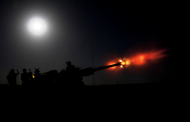Military tensions surged yesterday in Europe as NATO launched Operation Anaconda, the largest NATO military exercise in Eastern Europe since the end of the Cold War a quarter century ago, when the Stalinist bureaucracy dissolved the Soviet Union in 1991.
Some 31,000 troops, 3,000 vehicles, 105 aircraft, and 12 warships are participating in war games based on a scenario that war erupts between NATO and Russia, a nuclear-armed power. European defense officials in Warsaw said the scenario was one where there is “a mishap, a miscalculation which the Russians construe, or choose to construe, as an offensive action.”
The largest contingents in the exercises are 14,000 troops from the United States, 12,000 from Poland, and about 800 from Britain, as well as other forces, including from non-NATO countries. They will be commanded by Polish Lieutenant General Marek Tomaszycki.
Operation Anaconda is a massive provocation, effectively amounting to a dress rehearsal for a NATO invasion of Russia. In the exercise, for the first time since the Nazi invasions of Poland and the Soviet Union during World War II, German tanks will cross all of Poland from west to east.
With staggering recklessness, NATO officials are launching exercises dangerously close to Russian soil, even as security analysts acknowledge that this creates a situation where miscalculations could lead to war between NATO and Russia. According to the British Guardian, “defence experts warn that any mishap could prompt an offensive reaction from Moscow.” The daily cited Marcin Zaborowski, an official of the Center for European Policy Analysis, as admitting that the international situation surrounding Operation Anaconda is “tense, and accidents can happen.”
Russian officials reacted aggressively against escalating NATO military activity along Russia’s borders. The exercises in Poland come as 5,000 NATO forces carry out exercises code-named Operation Iron Wolf in Lithuania, the largest NATO deployment to Lithuania in several years, and amid NATO military exercises in Latvia, another Baltic republic bordering Russia.
“We do not hide that we have a negative attitude toward the NATO line of moving its military infrastructure to our borders, drawing other countries into military unit activities,” Russian Foreign Minister Sergey Lavrov said in Moscow. “This will activate Russia’s sovereign right to provide its own safety with methods that are adequate to today’s risks.”
Russian Permanent Representative to NATO Aleksandr Grusho said yesterday that Moscow would closely analyze NATO military activity in the region during the exercises. Russian military sources indicated that they would move three divisions closer to Russia’s western borders in response to the exercises, likely motorized rifle units of about 10,000 men each.
Operation Anaconda goes hand in hand with US and NATO operations aiming to encircle Russia’s entire western border, from the Baltics and Eastern Europe to the Balkans. Last month, NATO officials set up a missile base in Deveselu, Romania, and began work on a similar base at Redzikowo in northern Poland.
Yesterday, the US guided missile destroyer USS Porter sailed through the Bosphorus into the Black Sea with a strengthened missile armament—a year after a similar US warship in the Black Sea, the USS Ross, nearly violated Russian territorial waters, prompting a standoff with Russian warplanes.
All of these aggressive actions come in the run-up to the July 8-9 NATO summit in Warsaw, which is expected to further escalate NATO deployments to the Baltic region and tighten ties between NATO and former Soviet republics including Ukraine and Georgia, in the Caucasus.
Twenty-five years after the dissolution of the Soviet Union, the disastrous geopolitical implications of this event are ever more evident. The elimination of what capitalist propagandists of an earlier era called the “communist menace” did not lead to a flowering of peace and prosperity under the aegis of a capitalist European Union (EU). Rather, the dissolution of the Soviet Union and of the Warsaw Pact threw Eastern Europe open to imperialist intrigue and war plotting by Washington and its major allies in Europe.
The assurances NATO gave Moscow decades ago that its strategic interests would not be threatened have proven worthless. The 1997 NATO-Russia Founding Act said: “in the current and foreseeable security environment, the [NATO] Alliance will carry out its collective defense and other missions by ensuring the necessary interoperability, integration, and capability for reinforcement rather than by additional permanent stationing of substantial combat forces.”
Instead, as NATO absorbed countries across Eastern Europe, what emerged was a steady spread of NATO wars and combat forces across the continent. From NATO’s bloody Balkan wars in the former Yugoslavia in the 1990s and the brief 2008 war that Georgia recklessly launched against Russia with US support, the intervention has now escalated to the point that Russia is surrounded and directly threatened with invasion.
The pretense that NATO’s latest escalation is a legitimate response to a change in the European security environment due to Russian aggression in Ukraine is a political fraud. The war in Ukraine was provoked by a violent putsch, led by the fascistic Right Sector militia and supported by the CIA and the European capitals, that toppled a pro-Russian government in Kiev in 2014. As the current military situation with Operation Anaconda makes clear, it was not part of a Russian master plan to conquer Europe, but of a relentless and aggressive NATO drive to strategically isolate Russia.
This does not change in any way the fact that the actions of the Russian capitalist oligarchy in the Kremlin are politically reactionary. Incapable of and hostile to mobilizing opposition to war in the international working class, they oscillate between seeking an accommodation with the imperialist powers and threatening them with Russia’s military power.
Particularly as Russia faces ever more bellicose and right-wing regimes in Poland, Ukraine, and further afield in Eastern Europe, backed by Washington and its NATO allies, such threats simply escalate the danger of nuclear war.
The right-wing regime in Poland is in particular using Operation Anaconda to inaugurate the 35,000-strong nationalist territorial militias it has set up after cashiering a quarter of the country’s generals since it came to power last October. There are numerous reports that the territorial militias, drawn from Polish gun clubs and paramilitary groups, are linked to racist Polish football hooligan groups.
The deployment comes amid rising tensions between the EU and the Polish government, which has sought to sideline the country’s constitutional court. On June 1, the EU Commission issued a ruling demanding “concrete steps to resolve the systemic risk to the rule of law in Poland.”
The territorial militias are apparently viewed with concern in the Polish army and in NATO circles internationally. The Guardian cited an unnamed “Western defense expert” as saying: “Poland is highly regarded internationally. In the past 15 years, they spent a lot of money and created one of the best armies in the region… It is not clear what the government thinks it needs to improve.
By Alex Lantier
comments powered by HyperComments


